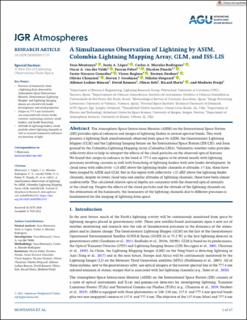| dc.contributor.author | Montanyà, Joan | |
| dc.contributor.author | López, Jesús A. | |
| dc.contributor.author | Morales Rodriguez, Carlos A. | |
| dc.contributor.author | van der Velde, Oscar A. | |
| dc.contributor.author | Fabró, Ferran | |
| dc.contributor.author | Pineda, Nicolau | |
| dc.contributor.author | Navarro-Gonzalez, Javier | |
| dc.contributor.author | Reglero, Victor | |
| dc.contributor.author | Neubert, Torsten | |
| dc.contributor.author | Chanrion, Olivier | |
| dc.contributor.author | Goodman, Steven J. | |
| dc.contributor.author | Østgaard, Nikolai | |
| dc.contributor.author | Ladino-Rincon, Alfonso | |
| dc.contributor.author | Romero, David | |
| dc.contributor.author | Solà, Glòria | |
| dc.contributor.author | Horta, Ricard | |
| dc.contributor.author | Freijó, Modesto | |
| dc.date.accessioned | 2022-04-11T10:37:25Z | |
| dc.date.available | 2022-04-11T10:37:25Z | |
| dc.date.created | 2022-01-19T11:34:31Z | |
| dc.date.issued | 2021 | |
| dc.identifier.issn | 2169-897X | |
| dc.identifier.uri | https://hdl.handle.net/11250/2990892 | |
| dc.description.abstract | The Atmosphere-Space Interactions Monitor (ASIM) on the International Space Station (ISS) provides optical radiances and images of lightning flashes in several spectral bands. This work presents a lightning flash simultaneously observed from space by ASIM, the Geostationary Lightning Mapper (GLM) and the Lightning Imaging Sensor on the International Space Station (ISS-LIS); and from ground by the Colombia-Lightning Mapping Array (Colombia-LMA). Volumetric weather radar provides reflectivity data to help to interpret the effects of the cloud particles on the observed optical features. We found that surges in radiance in the band at 777.4 nm appear to be related mostly with lightning processes involving currents as well with branching of lightning leaders with new leader development. In cloud areas with reflectivity <18 dBZ above the lightning leader channels at altitudes >7 km, these have been imaged by ASIM and GLM. But in the region with reflectivity <23 dBZ above the lightning leader channels, despite its lower cloud tops and similar altitudes of lightning channels, these have been almost undetectable. The calculated relative optical depths are consistent with the observed optical intensity at the cloud top. Despite the effects of the cloud particles and the altitude of the lightning channels on the attenuation of the luminosity, the luminosity of the lightning channels due to different processes is fundamental for the imaging of lightning from space. | en_US |
| dc.language.iso | eng | en_US |
| dc.publisher | AGU | en_US |
| dc.title | A Simultaneous Observation of Lightning by ASIM, Colombia-Lightning Mapping Array, GLM, and ISS-LIS | en_US |
| dc.type | Journal article | en_US |
| dc.type | Peer reviewed | en_US |
| dc.description.version | publishedVersion | en_US |
| dc.rights.holder | Copyright 2021 American Geophysical Union. All Rights Reserved. | en_US |
| dc.source.articlenumber | e2020JD033735 | en_US |
| cristin.ispublished | true | |
| cristin.fulltext | original | |
| cristin.qualitycode | 2 | |
| dc.identifier.doi | 10.1029/2020JD033735 | |
| dc.identifier.cristin | 1984537 | |
| dc.source.journal | Journal of Geophysical Research (JGR): Atmospheres | en_US |
| dc.identifier.citation | Journal of Geophysical Research (JGR): Atmospheres. 2021, 126 (6), e2020JD033735. | en_US |
| dc.source.volume | 126 | en_US |
| dc.source.issue | 6 | en_US |
